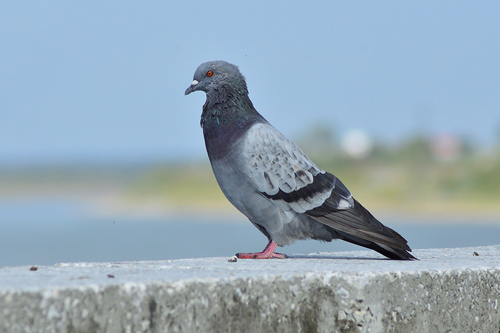
Rock Pigeon
The Rock Pigeon (Columba livia), often simply called "pigeon" in urban settings, is a ubiquitous bird found in cities and towns worldwide. Originally native to Europe, North Africa, and the Middle East, this species has been introduced and established feral populations across most of the globe. Rock Pigeons play a significant ecological role as seed dispersers and prey for urban raptors. They also hold cultural significance, having been domesticated for thousands of years for food, message carrying, and as racing birds. Their adaptability has allowed them to thrive in close proximity to humans, making them one of the most recognizable bird species.
29-37 cm
Length
62-72 cm
Wingspan
Least Concern
Conservation Status
Distribution
Native to Europe, North Africa, and the Middle East. Introduced and established worldwide, excluding Antarctica. They are found on every continent except Antarctica. They have no specific migratory routes, but feral populations may move locally in response to food availability.
Lifespan
Typically 3-5 years in the wild, but up to 15 years in captivity.
Rock Pigeon's Habitat
Habitat Types
Urban areas, Agricultural land, Cliffs and rocky outcrops
Climate Zones
Temperate, Subtropical, Tropical, Arid
Adaptations
Highly adaptable to human-altered environments. They can nest on buildings and other structures, and utilize a wide variety of food sources provided directly or indirectly by humans. They can also tolerate a wide range of temperatures.
Variations
Numerous feral populations exist, showing considerable variation in plumage. Several subspecies have been described, but the taxonomy is complex due to interbreeding with domestic pigeons.
Appearance
Breeding Plumage
No significant difference.
Seasonal Feather Changes
No significant seasonal variation.
Sex Based Plumage Differences
Minimal; males may have slightly more iridescence on the neck.
Notable Features
Iridescent neck feathers (green and purple), Two dark bars on each wing (in wild-type plumage), Reddish feet and legs, Dark bill with a white cere
Diet and Feeding
Primary Foods
Seeds, Grains, Fruits, Invertebrates (occasionally)
Foraging Behavior
Primarily ground feeders, pecking at seeds and other food items. Often found foraging in flocks, particularly in urban areas where food is abundant.
Specializations
They have a crop, a specialized pouch in the esophagus used to store food temporarily. This allows them to quickly gather food in exposed locations and digest it later in a safer place.
Seasonal Diet Variations
Diet may shift slightly based on local availability, but generally consistent year-round due to their adaptability and reliance on human-provided food sources.
Behavior
Social Structure
Highly social, often forming large flocks, especially in areas with abundant food resources. They maintain a dominance hierarchy within the flock.
Communication
Cooing vocalizations (used in courtship and territorial defense), Wing flapping (used in displays and alarm calls), Bowing displays
Migration
Generally non-migratory, although some populations may make short-distance movements in response to food availability or harsh weather.
Territorial or Group Behaviors
Males defend small territories around their nest sites. Outside of the breeding season, they are highly gregarious.
Conservation
Threats
Predation by raptors and other predators, Disease (e.g., avian pox, salmonellosis), Human persecution (in some areas)
Protection Programs
No specific conservation programs are in place due to their abundance.
Local National Laws
Generally not protected, and often considered a pest species in some urban areas.
Population Trend
Stable
Population Estimates
Estimated global population of feral Rock Pigeons is in the millions.
Interesting Facts
Rock Pigeons have excellent homing abilities.
They have been used for centuries to carry messages, relying on their ability to navigate back to their home loft from long distances.
They can see ultraviolet light.
This ability may aid in foraging and mate selection.
They produce 'crop milk' to feed their young.
This secretion is produced by both males and females and is essential for the chicks' growth and development.
Rock Pigeons can drink without lifting their heads.
Unlike most birds, they can suck up water continuously.
Faqs about Rock Pigeon
Are Rock Pigeons and doves the same thing?
Yes, pigeons and doves belong to the same family, Columbidae. 'Pigeon' typically refers to larger species, while 'dove' refers to smaller ones, but there's no strict scientific distinction.
Why are there so many different colored pigeons?
Feral Rock Pigeons exhibit a wide range of plumage colors due to interbreeding with domestic pigeons, which have been bred for various traits over centuries.
Do Rock Pigeons carry diseases?
They can carry some diseases transmissible to humans, but the risk is generally low with casual contact. It's best to avoid handling them directly and to wash your hands after contact with their droppings. Consult a professional for medical or expert advice.
How long do pigeons live?
In the wild, they typically live for 3-5 years. However, in captivity, they can live much longer, up to 15 years.
Copyright @ Nature Style Limited. All Rights Reserved.
 English
English